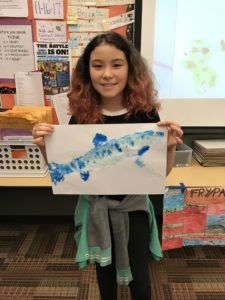We have much more to do and your continued support is needed now more than ever.
Reeling in Salmon Stewards

How do you transform children into wildlife stewards? By giving them an opportunity to foster animals at school. While many teachers opt for a furry class pet – an adorable guinea pig or the traditional rat – educators across Oregon are choosing a more locally significant species: salmon.
Through the Fish Eggs to Fry program, students are able to raise and observe native fish in classroom aquariums over a period of several weeks, from orange eggs to tiny free-swimming fry. Throughout this process, kids become citizen scientists, data analysts, empathetic caretakers, and eventual wildlife advocates, sparking a lifelong connection to one of Oregon’s keystone species.

Fish Eggs to Fry is an Oregon Department of Fish and Wildlife (ODFW) program, operating in over 800 classrooms across the state. For many years, the Association of Northwest Steelheaders (ANWS) – National Wildlife Federation’s (NWF) Oregon affiliate – has supported the program by delivering salmon or trout eggs to schools and assisting with release-days when fry are ready to strike out on their own. NWF, recognizing the impact of Fish Eggs to Fry, has deepened its involvement by connecting salmon education to its Eco-Schools USA program and partnering with ANWS to provide students with hands-on learning opportunities.
“We want Fish Eggs to Fry classrooms to earn credit for the work they’re doing to teach kids about watershed health and its effect on wildlife,” says Morgan Parks, Oregon education coordinator with NWF. By creating the Fish Eggs to Fry Audit and Action Plan and aligning it with the WOW (Watersheds, Oceans, and Wetlands) Pathway, NWF now offers an opportunity for schools to earn an Eco-Schools USA award through their salmon stewardship projects. “Classrooms can use this comprehensive, step-by-step audit to guide them through the process, connect what they’re learning to curriculum, and ultimately generate excitement about school sustainability initiatives,” says Parks.

In addition to introducing teachers to Eco-Schools USA, NWF and ANWS partner to bring interactive presentations to Fish Eggs to Fry classrooms. Through the “Fish Prints” activity, kids learn about salmon anatomy and adaptations while producing colorful artwork to display in school windows and hallways. In “So You Want to Be a Salmon?” children experience the salmon lifecycle through a challenging, high-energy game where they face fish ladders, predators, water turbines, and other obstacles on their perilous journey from stream to sea and back again. Another classroom presentation, “Fred the Fish,” teaches the importance of water quality by involving students in a messy and memorable pollution simulation, where soil, fertilizer, trash, car oil, and toxic waste are added to clean water to demonstrate how pollutants affect wildlife like Fred.

NWF will continue to expand its reach this year by working closely with five new schools in rural Clackamas County who are just getting started with Fish Eggs to Fry. By investing in students and teachers from a diverse range of schools, Oregon is building a strong collective of wildlife advocates who have a personal relationship with native fish species.
So what’s next for these budding salmon stewards? Hopefully – with a little encouragement from their teachers – an interest in science, a passion for protecting wildlife, and memories of the engaging lessons learned through Fish Eggs to Fry.
To learn more about the program and the collaborative efforts of ANWS and NWF, visit the Fish Eggs to Fry page on the Steelheaders website.
Learn More




















